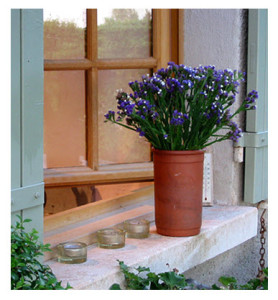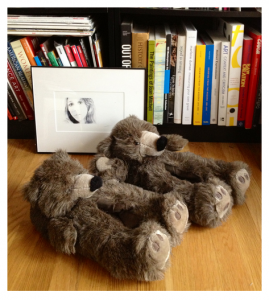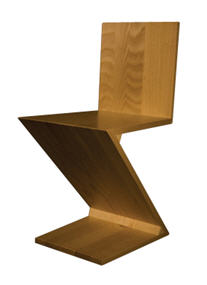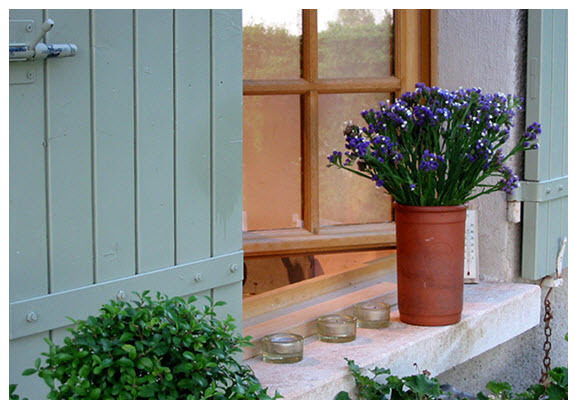Not long after I married and moved into a home with my husband, my mother offered to send me a large framed lithograph she knew I loved. She wanted me to pay for the cost of packing and shipping — considerable — and I was delighted to do so.
 Twenty-some years later, that artwork is still much loved, and will one day be passed along to my elder son.
Twenty-some years later, that artwork is still much loved, and will one day be passed along to my elder son.
My mother was in her fifties at the time and was beginning to feel a need to pare down her possessions.
How Do You Envision the Spaces and Places in Your Future?
While my longtime dream may have been a “someday” flat in Paris or a little stone cottage in Normandy or the south — those dreams, for now, seem distant and unlikely.
Naturally, any future space, from the Right Bank to the Left Coast, would probably require paring down to essentials merely as a matter of pragmatism.
My mother’s goals, I believe, were straightforward. She was very happy living in her rambling New England house, and had already converted much of the first floor to suit her needs without ever venturing up two flights of stairs. (She also rented out bedrooms in her home, and enjoyed the conversation and stimulation of her foreign student boarders.)
As she divested of certain belongings, my sense of her purpose is this. She sought a greater lightness of being, greater freedom from the burden of caring for things, and an expanded capacity to simply “be.”
Her future as she saw it?
Entirely comfortable in her kitchen, in her revised sleeping area and roomy living space — surrounded by her favorite possessions — and actively engaged with people.
How Do We Part With Much-Loved Things?
As a collector, many of my mother’s objects were cherished, not only for the patina of a worn surface or the impasto of a favored canvas, but for the stories of their discovery and the associated memories. I suspect that at various points in her fifties and sixties, she made several considered selections — seperating her most personally meaningful objects from those that she could more easily shed.
Her decision to offer a few things to me was a logical method of divesting, while honoring the sense of family history that came along for the ride.
 At the time, I was at a very different stage — just starting a family, a home to furnish on little money, and looking forward — very much in acquisition mode.
At the time, I was at a very different stage — just starting a family, a home to furnish on little money, and looking forward — very much in acquisition mode.
One of my sons once made the following observation: The things I am attached to are associated with people, places, memories and heritage. The objects are more than the objects themselves, and while their monetary value may be little or nil, their emotional value is immeasurable.
Another factor?
Some possessions are closely aligned to identity. Case in point — my stacks of books, particularly those that are literature, as well as my references on art. Another example: a friend’s souvenir tankards and small handcrafted sculptures, proudly displayed, and all picked up during a lifetime of traveling.
The Importance of Lightening the Load
As I periodically work to simplify and lighten, both logistically and emotionally, I struggle with efforts to shed. This is not a new challenge, though despite my discomfort with doing it, I’ve been at it again in recent months as I have at various junctures over the past 10 years.
I don’t wish to wait until I am ‘retired’ (a future I can’t even imagine), but rather to gradually ease into a continuous process I like to think of as streamlining.
I use the word streamlining intentionally and not euphemistically. It is truly how I perceive this activity — targeting a more maintainable lifestyle that ultimately yields far more than it sheds. And as I evaluate the process in more detail — certain items for my sons, though not now (they don’t have homes yet), certain items I can give away, other items to donate or to sell — I also recognize the time and skill involved in taking on the necessary tasks of decluttering productively.
All the more reason for approaching it gradually.
On a positive note, can’t we also view this process as necessary and helpful editing? Isn’t this always wise when revising our interiors, whatever the reason?
How Much Stuff Do We Need? Is It All “Emotional” Baggage?
Boxes of photographs dating from the time my children were babies line the top shelves and back area of my bedroom closet. Those are just the loose photographs; albums are stacked beneath hanging clothes and still others are tucked in the closet of another bedroom.
Along with pictures are folders filled with drawings, notes, letters and report cards — yes, my sons’ — and again, I cannot imagine “divesting” myself of these possessions.
 Sketches and paintings by my younger son? Artworks by friends and a few that were my mother’s? My grandmother’s china and treasured pieces of my own?
Sketches and paintings by my younger son? Artworks by friends and a few that were my mother’s? My grandmother’s china and treasured pieces of my own?
Once again, these are close to my heart. To shed these belongings would seem terribly difficult though I rarely use the Wedgwood plates, the crystal stems, the pottery vases… On the other hand, within five years after divorce I had sold or given away about half of what I had previously owned as part of the marital home. This was a function of both financial need and emotional “relief” at doing so.
Emotions are key. Emotions are tied to objects.
And the walls I run into in any ‘shedding’ undertaking are emotional. Clearly, I’m not alone in this particular battle.
The “Fresh Start” per The New York Times
The New York Times takes on this issue, positioning downsizing as a fresh start as we grow older.
Using the example of a 63-year-old woman who was undertaking this process, we are told:
… after living in the same house for 35 years — the home where she had raised three sons — downsizing, she said, was “definitely a big stress.”
Moreover…
Deciding what to do with a lifetime of possessions poses a multitude of questions and typically triggers a range of emotions.
While the process may be liberating in the long run, the emotional issues are nonetheless profound.
… don’t discount the pain involved. The difficulty in discarding things can be rooted in mortality and the realization that no one lives forever. At a certain point in life, there is more past than future, and that, in itself, can be daunting.
The Pleasure of Our Spaces
 Simplicity to me is relative. I seek simpler without feeling set adrift were I to strip myself of too many of the possessions that tell my family’s stories. For that matter, some of these belongings are sources of ongoing enjoyment.
Simplicity to me is relative. I seek simpler without feeling set adrift were I to strip myself of too many of the possessions that tell my family’s stories. For that matter, some of these belongings are sources of ongoing enjoyment.
By way of example, my stacks and shelves of books, a few antique child’s chairs, a pair of zigzags (beautiful and great for the back!), and the artworks mentioned by my son and friends. Big red chairs delight me with their passionate color and provide another element of visual and tangible comfort. Permit me to mention that in recent months I have tossed at least a dozen pair of shoes (really!) and a half dozen towering stacks of fashion and design magazines.
Have I missed them?
Not at all. Proof positive that I can do this, bit by bit, while still retaining the coziness of my space, with a goal of “lighter” of being, if not some absolute state of imagined “lightness.” And I say as much as I look to streamline for the emotional enhancement to my life as well as no longer feeling like a caretaker of things. Yet I know I must respect my own pleasure in my surroundings, as well as maintaining the sense of home for my sons.
You May Also Enjoy

I’m not nearly ready to start divesting myself of things yet. I wrote a post last year called “Treasure Hunting” where I talked about some of my treasures and how I came by them…. mostly due to my grandmother and mother doing their own divesting. Things still give me joy…. so I’m holding onto them. But I’m not adverse to dumping all my old teaching files, and university textbooks, and Hubby’s velour shorts from the seventies:)
I hear you on the university texts and old shorts! 😉 I find I can’t part with things that were my mother’s and grandmother’s (both gone many years now). So I get that, too…
Oh dear…I’m laughing at my comment. I meant shirts…velour shirts. That’s funny. Even in Hubby’s worst fashion moments….I can’t picture him in velour shorts!
🙂
I struggle with hanging onto things because I am avoiding a decision regarding what to do with them. However, I am learning that there is great freedom in letting go and very seldom have I missed something with which I have parted. I love the idea of releasing things to family so that they are not abandoned or lost. I look forward to the day I can do that! Also, I find greater satisfaction when I know something that no longer serves me is being used or appreciated by another. I have passed furniture on to our “starving” college student babysitter, I have donated quality childrenswear to families that I know will be using them, etc. I am starting to weigh the value of what I actually use against the cost to keep, maintain, store, etc. It’s a process, with much back and forth and lots of inaction!
Being a “Dyed-in-the-Wool” neat nut, this one is near and dear to me. When my dear parents passed, I was the son in the family tasked with removing the “Anchor Stuff.” This is what I call all the junk that people collect. When I realized how useless all this stuff was that my parents collected and hoarded in two homes, (one of them being in a foreign country) to other people, I swore that I would never burden my 3 sons with this. Accordingly, now at age 74, still fit, trim and healthy; I am happy to say that I live in a very nice, neat, apartment, have a very nice car, a very nice wardrobe, and my golf clubs! When my time comes, it will take my sons about 2 hours to button things up, leaving ample time for all who have assembled to have more drinks, talk and laugh, and reminisce about what a great father and guy I was! Aside from money, the only things that have to be distributed are: My watch, my pistol, and my golf clubs. I mean….after all….certain things you just can’t live without!
I wish to amend this. It was very poorly explained. What I meant to say was: Many very nice and very expensive possessions left behind by my parents, much to my dismay, were in many cases, of very little to no interest, to other people. Also I should not have used the word “Junk.” That is very insensitive! I should have said belongings or something of that nature. So….. what I tried to convey was: When we get to that certain age and/or time in our life, we should begin to distribute certain heirlooms and valuable possessions to family and friends so that in the event of a sudden departure, St. Vincent De Paul, Good Will, and The Salvation Army, don’t make a “Killing” (No Pun Intended) due to poor planning on our part! That is NOT to say that those organizations don’t help a lot of people with what they do.
I feel better now! Hope I didn’t offend others!
I read this and know I should be divesting myself of various objects including clothes but…. it does seem overwhelming. I’d love pieces to go to my children. And what about when my grandchildren get older? Wouldn’t they like some of grandma and grandpa’s things? Oh well, I’ll think about it some other day. Seems the right course of action. 🙂
You hit all the bases on this issue, beautifully. I really appreciate your ongoing observations about this process, as I too work, gradually, to travel lighter and to know that what I keep is important to me. It is taking me such a long time just to go through all the information on paper that I accumulated over the child-rearing years when there was no time to sort and classify, file or dispose of these records, etc. I haven’t even started with objects, much less memorabilia regarding the children. It is very difficult to spend precious time off doing this, but the last thing I want to do is burden the children with the job after we are gone. Courage!!
Thanks for stopping by, Leslie. Thank you for the good words. (Always lovely to hear from you.)